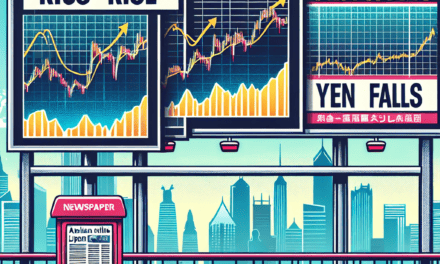“Dollar Soars as Stock Futures Dive: Strong US Jobs Report Shakes Markets.”
Introduction
The U.S. dollar experienced a significant surge following the release of a robust jobs report, which indicated stronger-than-expected employment growth and bolstered investor confidence in the economy. This positive labor market data led to a sharp decline in stock futures, as market participants recalibrated their expectations for future interest rate hikes by the Federal Reserve. The contrasting movements in the currency and equity markets highlight the ongoing volatility and the complex interplay between economic indicators and investor sentiment.
Dollar Strength: Analyzing the Impact of Strong US Jobs Report
The recent surge in the value of the U.S. dollar can be attributed to the release of a robust jobs report, which has sent ripples through financial markets. This report, showcasing significant job growth and a decrease in unemployment rates, has not only bolstered confidence in the U.S. economy but has also influenced investor sentiment across various asset classes. As the dollar strengthens, it is essential to analyze the implications of this development, particularly in relation to stock futures, which have experienced a notable decline in response to the jobs data.
The strong jobs report indicates that the labor market remains resilient, with employers adding a substantial number of jobs and wages showing signs of growth. This positive employment data typically signals a healthy economy, prompting expectations of increased consumer spending and overall economic activity. However, while a thriving job market is generally seen as a positive indicator, it can also lead to concerns about inflationary pressures. As wages rise, there is a potential for increased consumer spending, which could drive prices higher. Consequently, this scenario raises the likelihood of the Federal Reserve adopting a more aggressive stance on interest rates to curb inflation.
In light of these developments, the dollar has gained strength against a basket of currencies. Investors often flock to the dollar during times of economic uncertainty or when they anticipate higher interest rates, as it is perceived as a safe haven. The strong jobs report has reinforced expectations that the Federal Reserve may continue its path of monetary tightening, further enhancing the dollar’s appeal. As a result, the greenback’s appreciation has implications for international trade, as a stronger dollar makes U.S. exports more expensive for foreign buyers while making imports cheaper for American consumers.
Conversely, the stock market has reacted negatively to the jobs report, with futures plunging in the aftermath of the data release. This decline can be attributed to the fear that rising interest rates could dampen corporate profits. Higher borrowing costs can lead to reduced capital expenditures and consumer spending, which are critical drivers of economic growth. As investors digest the implications of the jobs report, many are reassessing their positions in equities, leading to a sell-off in stock futures. This reaction underscores the delicate balance that exists between a strong labor market and the potential for tighter monetary policy.
Moreover, the interplay between the dollar’s strength and stock market performance highlights the complexities of the current economic landscape. While a robust jobs report is typically a cause for celebration, it can also trigger a chain reaction that affects various sectors of the economy. For instance, industries reliant on exports may face headwinds due to the stronger dollar, while sectors tied to consumer spending may experience volatility as interest rates rise. As such, investors must remain vigilant and adaptable in navigating these shifting dynamics.
In conclusion, the recent strong U.S. jobs report has led to a significant appreciation of the dollar, while simultaneously causing stock futures to plunge. This scenario illustrates the intricate relationship between employment data, monetary policy, and market sentiment. As the economy continues to evolve, stakeholders must carefully monitor these developments to make informed decisions in an increasingly complex financial environment. The interplay between a strong labor market and the potential for rising interest rates will undoubtedly shape the economic landscape in the months to come, influencing both currency valuations and stock market performance.
Stock Market Reaction: Understanding Futures Plunge After Jobs Data
The recent surge in the value of the U.S. dollar, juxtaposed with a notable decline in stock futures, has captured the attention of investors and analysts alike. This phenomenon can be traced back to the release of a robust jobs report, which, while indicative of a strengthening labor market, has also raised concerns about potential shifts in monetary policy. As the data unfolded, it became clear that the implications of such a strong employment figure were multifaceted, influencing market sentiment in various ways.
Initially, the jobs report revealed an increase in non-farm payrolls that exceeded expectations, suggesting that the economy was not only recovering but gaining momentum. This positive news typically would bolster investor confidence, leading to a rally in stock prices. However, the immediate reaction in the futures market was quite the opposite. The plunge in stock futures can be attributed to the anticipation of tighter monetary policy from the Federal Reserve. Investors began to speculate that the strong job numbers could prompt the central bank to accelerate interest rate hikes, a move that could dampen economic growth and corporate profits.
Moreover, the relationship between interest rates and stock valuations is critical to understanding this market reaction. When interest rates rise, the cost of borrowing increases, which can lead to reduced consumer spending and investment. Consequently, higher rates often result in lower future cash flows for companies, leading to a decline in stock prices. As futures began to reflect this sentiment, traders adjusted their positions, resulting in a downward spiral for equity markets.
In addition to the immediate impact on stock futures, the strong jobs report also had a pronounced effect on the bond market. Yields on U.S. Treasury bonds surged as investors anticipated a more aggressive stance from the Federal Reserve. This increase in yields further compounded the pressure on equities, as higher bond yields make fixed-income investments more attractive relative to stocks. Consequently, the flight to safety became evident, with investors reallocating their portfolios in response to the shifting economic landscape.
Furthermore, the dollar’s ascent can be understood within this context. A stronger dollar often reflects expectations of higher interest rates, as foreign investors seek to capitalize on better returns in the U.S. market. As the dollar appreciated, it created additional headwinds for U.S. exporters, whose goods become more expensive for foreign buyers. This dynamic can lead to concerns about the profitability of companies reliant on international sales, further contributing to the bearish sentiment in the stock market.
As the day progressed, market participants continued to digest the implications of the jobs report, weighing the potential for sustained economic growth against the risks associated with rising interest rates. The volatility in stock futures serves as a reminder of the interconnectedness of economic indicators and market reactions. Investors are now faced with the challenge of navigating a landscape where strong economic data can simultaneously inspire confidence and provoke caution.
In conclusion, the recent plunge in stock futures following a strong U.S. jobs report underscores the complexities of market dynamics. While robust employment figures typically signal economic strength, they can also trigger fears of tighter monetary policy, leading to a reevaluation of asset valuations. As the dollar soars, the interplay between interest rates, stock prices, and investor sentiment will continue to shape the financial landscape, requiring careful analysis and strategic decision-making from market participants.
Economic Indicators: The Role of Employment Reports in Currency Valuation
The relationship between employment reports and currency valuation is a critical aspect of economic analysis, particularly in the context of the recent surge in the value of the U.S. dollar following a robust jobs report. Employment indicators, such as the non-farm payrolls report, serve as vital barometers of economic health, influencing not only domestic policy but also international perceptions of a currency’s strength. When employment figures exceed expectations, as they did in the latest report, it often signals a resilient economy, prompting investors to reassess their positions in various asset classes, including currencies.
In this context, a strong jobs report typically leads to increased confidence in the U.S. economy. As employment rises, consumer spending tends to follow suit, bolstering economic growth. This positive feedback loop can lead to expectations of tighter monetary policy from the Federal Reserve, as a strong labor market may compel the central bank to raise interest rates to combat potential inflation. Consequently, higher interest rates generally attract foreign capital, driving up demand for the dollar. Thus, the immediate aftermath of a favorable employment report often sees the dollar appreciating against other currencies, as was evident in the recent market reaction.
Moreover, the implications of employment data extend beyond mere currency valuation; they also impact stock market performance. When the jobs report indicates a thriving labor market, it can lead to a paradoxical situation where stock futures decline. Investors may interpret strong employment figures as a precursor to tighter monetary policy, which could dampen corporate profits and economic expansion. This duality illustrates the complex interplay between different economic indicators and market reactions. As stock futures plunge in response to the prospect of rising interest rates, the dollar’s ascent reflects a flight to safety, as investors seek stability in a strong currency amidst market volatility.
Furthermore, the global economic landscape is intricately linked to U.S. employment data. Many countries and their currencies are influenced by the performance of the U.S. economy, given its status as a leading global economic power. For instance, emerging markets often experience capital outflows when the dollar strengthens, as investors seek higher returns in the U.S. This dynamic can lead to increased volatility in foreign exchange markets, as currencies of developing nations may depreciate in response to a stronger dollar. Thus, the ramifications of U.S. employment reports extend far beyond domestic borders, affecting global trade and investment flows.
In addition to immediate market reactions, the long-term implications of employment reports on currency valuation cannot be overlooked. Sustained improvements in the labor market can lead to structural changes in the economy, influencing everything from consumer confidence to business investment. As the labor market tightens, wage growth may accelerate, further fueling inflationary pressures. In this scenario, the Federal Reserve’s response becomes crucial, as its policy decisions will shape the trajectory of both the dollar and the broader economy.
In conclusion, employment reports play a pivotal role in shaping currency valuation, with strong job growth typically leading to a stronger dollar and potential declines in stock futures. The intricate relationship between these economic indicators underscores the importance of monitoring labor market trends, as they provide valuable insights into the overall health of the economy and its implications for both domestic and global financial markets. As investors navigate this complex landscape, understanding the nuances of employment data will remain essential for making informed decisions in an ever-evolving economic environment.
Investor Sentiment: How Strong Jobs Data Influences Market Confidence
The recent surge in the value of the U.S. dollar, juxtaposed with a notable decline in stock futures, underscores the intricate relationship between employment data and investor sentiment. When the U.S. Labor Department released its latest jobs report, the figures exceeded expectations, revealing robust job growth and a declining unemployment rate. Such strong employment data typically instills confidence in the economy, suggesting that consumer spending may remain resilient. However, the immediate market reaction was somewhat paradoxical, as stock futures plummeted despite the positive news.
This phenomenon can be attributed to the complex dynamics of investor psychology and market expectations. While strong job growth is generally perceived as a positive indicator of economic health, it can also lead to concerns about inflationary pressures. Investors often interpret robust employment figures as a signal that the Federal Reserve may adopt a more aggressive stance on interest rates to curb potential inflation. Consequently, the anticipation of higher interest rates can dampen enthusiasm for equities, leading to a sell-off in stock futures. This reaction illustrates how investor sentiment is not solely driven by the data itself but also by the implications that such data may have on monetary policy.
Moreover, the relationship between job growth and market confidence is further complicated by the broader economic context. For instance, while a strong jobs report may initially boost confidence, it can also raise questions about the sustainability of such growth. Investors may begin to ponder whether the economy can maintain its momentum in the face of potential headwinds, such as geopolitical tensions or supply chain disruptions. As a result, even positive employment data can trigger a reevaluation of risk, prompting investors to shift their focus from growth-oriented assets to safer havens, such as the dollar.
In addition, the strong jobs report can lead to a recalibration of market expectations regarding corporate earnings. When employment levels rise, it often translates to increased consumer spending, which is generally favorable for businesses. However, if investors believe that rising wages could squeeze profit margins or that higher interest rates might stifle economic growth, they may become more cautious about future earnings projections. This cautious sentiment can further exacerbate declines in stock futures, as investors reassess their positions in light of potential economic shifts.
Furthermore, the interplay between the dollar and stock markets highlights the multifaceted nature of investor sentiment. A soaring dollar can have mixed implications for different sectors of the economy. For instance, while a stronger dollar may benefit consumers by lowering import costs, it can adversely affect multinational corporations that rely on exports. As these companies face reduced competitiveness abroad, their stock prices may suffer, contributing to the overall decline in stock futures. Thus, the dollar’s ascent, driven by strong jobs data, can create a ripple effect throughout the market, influencing investor sentiment in various ways.
In conclusion, the recent strong U.S. jobs report serves as a reminder of the delicate balance between economic indicators and market reactions. While robust employment figures typically bolster confidence in the economy, they can also raise concerns about inflation and interest rates, leading to a complex interplay of investor sentiment. As market participants navigate these dynamics, the relationship between job growth and stock performance remains a critical area of focus, illustrating the nuanced nature of financial markets in response to economic data.
Currency Trends: The Dollar’s Performance Against Global Peers
In recent weeks, the U.S. dollar has demonstrated remarkable strength against a basket of global currencies, a trend that has been particularly pronounced following the release of a robust jobs report. This report, which indicated a significant increase in employment figures, has had a profound impact on market sentiment, leading to a surge in the dollar’s value. As investors reacted to the positive economic data, the dollar’s performance against its global peers became a focal point of analysis, revealing insights into the broader economic landscape.
The strong jobs report not only bolstered confidence in the U.S. economy but also raised expectations regarding future monetary policy decisions by the Federal Reserve. As the labor market showed signs of resilience, market participants began to speculate on the possibility of interest rate hikes, which typically enhance the attractiveness of a currency. Consequently, the dollar appreciated against major currencies such as the euro, yen, and pound, reflecting a shift in investor sentiment towards the U.S. economy’s relative strength.
In contrast, stock futures plummeted in response to the jobs report, as investors recalibrated their expectations for corporate earnings in an environment of potentially rising interest rates. This divergence between the performance of the dollar and the stock market underscores the complex interplay between currency values and equity markets. While a strong dollar can be beneficial for consumers by lowering import costs, it can also pose challenges for exporters, as their goods become more expensive for foreign buyers. This duality highlights the nuanced effects of currency fluctuations on different sectors of the economy.
Moreover, the dollar’s ascent has implications for emerging markets, where many countries rely on dollar-denominated debt. As the dollar strengthens, the cost of servicing this debt increases, potentially leading to financial strain in these economies. Investors in emerging markets may find themselves reassessing their positions, as a stronger dollar can lead to capital outflows and increased volatility. This dynamic further emphasizes the interconnectedness of global financial markets and the ripple effects that changes in the U.S. economy can have worldwide.
As the dollar continues to gain traction, analysts are closely monitoring key economic indicators that could influence its trajectory. Factors such as inflation rates, consumer spending, and geopolitical developments will play a crucial role in shaping the dollar’s performance in the coming months. For instance, if inflation remains elevated, the Federal Reserve may be compelled to adopt a more aggressive stance on interest rates, further supporting the dollar’s strength. Conversely, any signs of economic slowdown could prompt a reassessment of the Fed’s policy approach, potentially leading to a weakening of the dollar.
In conclusion, the recent surge in the dollar’s value against global currencies is a reflection of the positive economic signals emanating from the U.S. labor market. As investors navigate the complexities of currency trends and their implications for both domestic and international markets, the interplay between the dollar and stock futures will remain a critical area of focus. Understanding these dynamics is essential for market participants seeking to make informed decisions in an ever-evolving economic landscape. As the situation unfolds, the dollar’s performance will undoubtedly continue to be a key indicator of broader economic health and investor sentiment.
Future Projections: What Strong Jobs Data Means for Economic Outlook
The recent surge in the value of the U.S. dollar, coupled with a significant decline in stock futures, can be attributed to the release of a robust jobs report that has sent ripples through financial markets. This strong jobs data not only reflects the current health of the labor market but also carries implications for the broader economic outlook. As investors digest the information, it becomes essential to consider what this means for future economic conditions and monetary policy.
Firstly, the strong jobs report indicates that the U.S. economy is experiencing resilience, with employment figures surpassing expectations. This development suggests that consumer spending, which is a critical driver of economic growth, is likely to remain robust. When more individuals are employed, disposable income increases, leading to higher consumption levels. Consequently, this could bolster economic growth in the near term, as businesses may respond to increased demand by expanding operations and hiring additional staff.
However, while the immediate outlook appears positive, the implications of strong job growth are multifaceted. One significant concern is the potential for inflationary pressures to intensify. As the labor market tightens, wages may rise as employers compete for a limited pool of workers. Higher wages can lead to increased consumer spending, which, while beneficial for economic growth, can also contribute to inflation if supply does not keep pace with demand. Therefore, the Federal Reserve may need to reassess its monetary policy stance in light of these developments.
In response to the strong jobs report, market participants are likely to anticipate a more aggressive approach from the Federal Reserve regarding interest rates. If the central bank perceives that the economy is overheating due to strong employment figures, it may opt to raise interest rates more quickly than previously expected. This potential shift in monetary policy could lead to higher borrowing costs for consumers and businesses, which may, in turn, dampen economic activity. As a result, the stock market may react negatively to the prospect of increased interest rates, leading to the observed plunge in stock futures.
Moreover, the strong jobs data could also influence investor sentiment regarding the overall economic trajectory. While a thriving labor market is generally viewed as a positive indicator, concerns about inflation and rising interest rates may create a sense of uncertainty. Investors often seek to balance risk and reward, and in an environment where monetary policy may tighten, they may become more cautious. This cautious sentiment can lead to volatility in equity markets, as seen in the recent decline in stock futures.
In conclusion, the strong jobs report presents a complex picture for the U.S. economy. While it signals a healthy labor market and potential for continued economic growth, it also raises concerns about inflation and the subsequent response from the Federal Reserve. As the dollar strengthens and stock futures decline, market participants must navigate the delicate balance between optimism for economic expansion and the risks associated with rising interest rates. Ultimately, the future economic outlook will depend on how these dynamics unfold in the coming months, as both consumers and investors adjust to the evolving landscape shaped by robust employment figures.
Market Strategies: Navigating Volatility in Response to Economic Reports
In the ever-evolving landscape of financial markets, the release of economic reports often serves as a catalyst for significant market movements. Recently, the U.S. jobs report revealed stronger-than-expected employment figures, which sent the dollar soaring while simultaneously causing stock futures to plunge. This juxtaposition highlights the intricate relationship between currency strength and equity market performance, underscoring the need for investors to adopt strategic approaches in navigating such volatility.
As the dollar gains strength, it typically reflects investor confidence in the U.S. economy. A robust jobs report suggests that businesses are hiring, consumer spending may increase, and overall economic growth is likely to continue. Consequently, this positive sentiment can lead to a stronger dollar, as foreign investors seek to capitalize on the perceived stability and growth potential of U.S. assets. However, the immediate reaction in the stock market often tells a different story. When economic indicators point to potential interest rate hikes by the Federal Reserve, as they often do following strong employment data, investors may fear that higher borrowing costs could stifle corporate profits. This fear can lead to a sell-off in equities, resulting in plunging stock futures.
In light of these dynamics, investors must remain vigilant and adaptable. One effective strategy is to diversify portfolios to mitigate risk during periods of heightened volatility. By spreading investments across various asset classes, including bonds, commodities, and international equities, investors can cushion their portfolios against sharp market fluctuations. Furthermore, incorporating defensive stocks—companies that tend to perform well regardless of economic conditions—can provide stability during turbulent times.
Another important consideration is the timing of trades. In the wake of significant economic reports, market reactions can be swift and unpredictable. Therefore, employing a disciplined approach to trading can be beneficial. Investors may consider setting predetermined entry and exit points based on technical analysis, allowing them to capitalize on market movements without succumbing to emotional decision-making. This method not only helps in managing risk but also ensures that investors remain focused on their long-term objectives.
Moreover, staying informed about macroeconomic trends and central bank policies is crucial for navigating market volatility. Understanding the broader economic context can provide valuable insights into potential market movements. For instance, if the Federal Reserve signals a commitment to raising interest rates in response to strong job growth, investors may want to reassess their exposure to interest-sensitive sectors, such as real estate and utilities. Conversely, sectors that benefit from a strong economy, such as technology and consumer discretionary, may present opportunities for growth.
In addition to these strategies, utilizing options and other derivatives can offer investors a way to hedge against potential losses. By employing protective puts or covered calls, investors can create a buffer against adverse market movements while still participating in potential upside. This approach allows for greater flexibility in managing risk, particularly during periods of uncertainty.
Ultimately, the recent surge in the dollar alongside the decline in stock futures serves as a reminder of the complexities inherent in financial markets. By adopting a proactive and informed approach, investors can navigate the volatility that often accompanies economic reports. Through diversification, disciplined trading, and a keen awareness of macroeconomic trends, investors can position themselves to not only weather the storm but also seize opportunities that arise in the wake of market fluctuations.
Q&A
1. **Question:** What was the immediate market reaction to the strong US jobs report?
**Answer:** Stock futures plunged while the dollar soared.
2. **Question:** Why did the strong US jobs report impact stock futures negatively?
**Answer:** Investors anticipated that strong job growth could lead to higher interest rates, which often negatively affects stock prices.
3. **Question:** How did the dollar perform in response to the jobs report?
**Answer:** The dollar strengthened significantly against other currencies.
4. **Question:** What specific data from the jobs report contributed to the market’s reaction?
**Answer:** The report showed a higher-than-expected increase in non-farm payrolls and a decrease in the unemployment rate.
5. **Question:** What are the implications of a stronger dollar for international trade?
**Answer:** A stronger dollar can make US exports more expensive and imports cheaper, potentially widening the trade deficit.
6. **Question:** How do investors typically respond to strong job growth in the context of Federal Reserve policy?
**Answer:** Investors often expect the Federal Reserve to raise interest rates to combat inflation, leading to volatility in stock markets.
7. **Question:** What sectors of the stock market are usually most affected by rising interest rates?
**Answer:** Interest-sensitive sectors such as utilities, real estate, and consumer discretionary are typically most affected.
Conclusion
The strong US jobs report has led to a significant appreciation of the dollar, reflecting investor confidence in the economy and expectations of potential interest rate hikes. Conversely, stock futures have declined as concerns about rising rates may dampen corporate profits and economic growth. This divergence highlights the market’s reaction to economic indicators, with the dollar strengthening amid uncertainty in equity markets.





